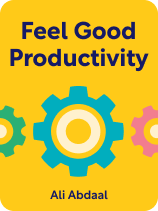

This article is an excerpt from the Shortform book guide to "Feel-Good Productivity" by Ali Abdaal. Shortform has the world's best summaries and analyses of books you should be reading.
Like this article? Sign up for a free trial here.
Are you trying to do too much at work? Have you spread yourself too thin?
Just like exercising too much can cause you to strain a muscle, doing too much can cause you to “strain” your well-being. You can avoid or recover from this type of burnout by taking a healthier approach to your day-to-day work.
Below are two tips on how to stop doing too much.
1. Prioritize, and Be Honest About Your Priorities
The first piece of advice on how to stop doing too much is to be honest with yourself and others about how much you can do. Make a list of all the projects you’re working on—both professional and personal—and see if it’s realistic based on how much you can comfortably get done.
If you find that you’re regularly shifting into the grind mindset to meet all your commitments, then you’ve taken on too much and may be heading for burnout. In that case, it’s time to prioritize and simplify. Which projects on that list are most important to you? If you had to pick just one project to devote yourself to, which one would it be?
Ali Abdaal adds that, to avoid this type of burnout, you need to get comfortable with telling people “no.” Remember that other people don’t know exactly how much work you’re doing or how much energy you have, so they’ll often ask you to take on more work when that isn’t feasible for you. Trying to please everyone is a sure way to burn yourself out.
2. Choose Your Distractions Carefully
Abdaal’s second tip to stop doing too much and avoid burnout due to strain is to manage your distractions. Shifting your attention from one thing to another (task-switching) too frequently uses up your mental energy.
Crucially, the author doesn’t say that you should remove all distractions from your life. For one thing, that’s impossible; for another, occasional breaks actually improve your focus when you get back to your main task. However, he does suggest indulging in distractions that make you feel good, instead of distractions that simply fill time.
| Two Sides to Task-Switching By discussing task-switching, Abdaal contributes to the ongoing discussion of multitasking, specifically whether multitasking is a source of productivity or a hindrance to it. Many psychologists, as well as productivity books like Brian Tracy’s Eat That Frog, say that multitasking is a myth: It’s impossible to focus on two things at the same time, and so-called “good multitaskers” are actually good task-switchers. However, Tracy adds that task-switching is detrimental to your productivity no matter how good you are at it; trying to do two things at once can make each task take up to five times as long. Abdaal disagrees to some extent by saying task-switching does help your productivity, as long as you do it deliberately and in moderation. |
Abdaal says it’s likely that managing distractions means rethinking your relationship with technology, especially with your phone. When you have a smartphone, you’re constantly bombarded with distractions such as emails, app notifications, and social media feeds. Therefore, Abdaal suggests uninstalling any apps that you can live without and setting strict limits about when and how much you’ll use your phone for things like emails.
So, instead of checking your phone or browsing your favorite websites whenever you need a break, try looking for positive distractions. For example, you could try stretching, taking a walk, reading an uplifting book, or talking to a friend.
(Shortform note: The constant distractions from phones and other devices may be even more disruptive than Abdaal suggests. In ADHD 2.0, Edward Hallowell and John Ratey—two doctors who specialize in treating ADHD—say that even people who don’t have ADHD are beginning to show symptoms mimicking the condition. The authors explain that these ADHD-like traits, such as the inability to stay focused and the compulsive need to check their phones, are the result of people trying to keep up with a constant barrage of information that comes in more quickly than their brains can process it.)

———End of Preview———
Like what you just read? Read the rest of the world's best book summary and analysis of Ali Abdaal's "Feel-Good Productivity" at Shortform.
Here's what you'll find in our full Feel-Good Productivity summary:
- How to stop procrastination at its source and avoid or recover from burnout
- The crucial link between emotional health and productivity
- How to work in ways that feel energizing instead of draining






